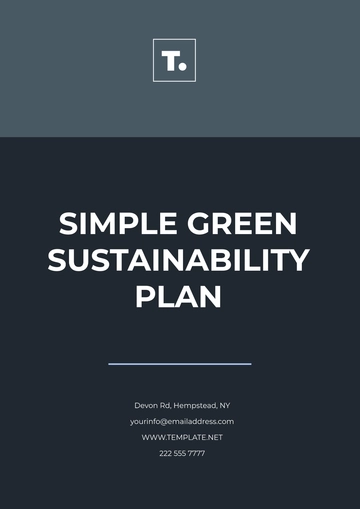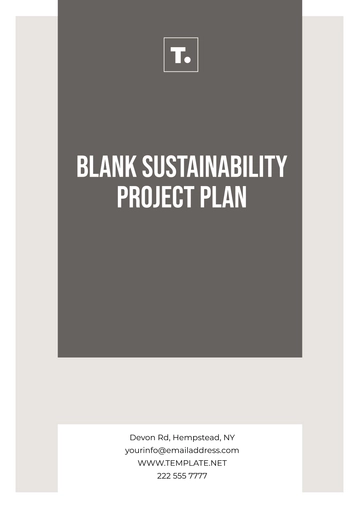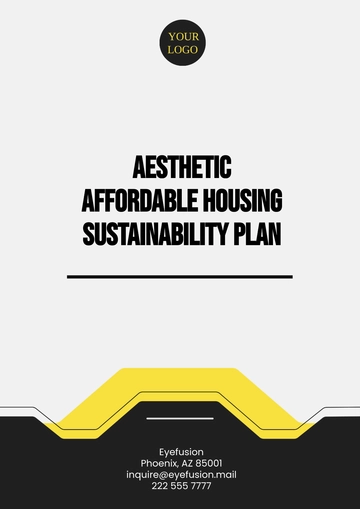Free Climate Change Advocacy Plan

I. Executive Summary
This Climate Change Advocacy Plan, created by [Your Company Name], outlines our strategic efforts to address and combat the urgent challenges of climate change by 2053. The plan focuses on influencing policy change, promoting sustainable practices, and raising public awareness to ensure that the world is on track to meet the climate goals set by the Paris Agreement. Our key stakeholders include government leaders, businesses, communities, and environmental organizations, all working toward a shared goal of reducing global carbon emissions by 50% by 2053.
II. Introduction
A. Background and Context of Climate Change
By 2050, the global temperature has already risen by 1.8°C above pre-industrial levels, and climate-related disasters such as wildfires, floods, and hurricanes are becoming more frequent and severe. The scientific consensus underscores the need for urgent action to mitigate the impacts of climate change and adapt to its consequences. As a responsible corporate entity, [Your Company Name] recognizes the critical need to contribute to global climate efforts.
B. Importance of Climate Change Action
Failing to act swiftly on climate change will result in devastating effects on ecosystems, human health, and economic stability. Our advocacy plan is designed to create awareness and push for actions that can reduce the environmental impact and promote long-term sustainability. Taking action now is essential for preserving the planet for future generations.
C. Rationale for the Advocacy Plan
This advocacy plan will provide a structured approach to mobilize action on climate change by focusing on policy, education, and corporate responsibility. [Your Company Name] is committed to leading the charge in advocating for climate-smart policies while demonstrating the business case for sustainability. By aligning our advocacy with global climate targets, we aim to ensure a healthier, more resilient world.
D. Scope and Focus Areas of the Advocacy Efforts
Our efforts will focus on three key areas: policy advocacy for carbon-neutral legislation, community-driven awareness campaigns, and partnerships with businesses to implement sustainable practices. This comprehensive approach will target local, national, and international stakeholders, ensuring broad support for climate solutions.
III. Goals and Objectives
A. Long-term Goals
Achieve a global reduction in carbon emissions by 50% by 2053.
Influence the adoption of comprehensive climate change legislation in 30+ countries by 2053.
Educate 100 million people globally on sustainable practices by 2053.
B. Short-term Objectives
Launch a global public awareness campaign on climate change by mid-2051.
Secure commitments from 500 corporations for carbon reduction by the end of 2052.
Facilitate at least 20 policy dialogues with international policymakers in 2051.
C. Key Performance Indicators (KPIs)
Objective | Target Metric | Timeline |
|---|---|---|
Global carbon reduction | 50% reduction in global emissions | By 2053 |
Public awareness campaign reach | 100 million people reached | By 2053 |
Corporate commitment for sustainability | 500 corporate commitments | By 2052 |
IV. Target Audiences
A. Policymakers and Government Officials
To effect lasting change, we must engage with national and regional policymakers, particularly those in the European Union, U.S., China, and emerging economies. We will focus on building relationships with key government leaders who can influence climate policies and legislation. This includes collaborating with existing climate networks to amplify our voice in policy discussions.
B. Businesses and Industry Leaders
Our plan also aims to engage leading businesses, especially in sectors with high carbon footprints, such as energy, manufacturing, and agriculture. By partnering with 500 corporations, we will advocate for the adoption of net-zero emissions strategies and sustainable practices in business operations. In addition, we will focus on the financial sector to secure investments in clean energy and green technologies.
C. Communities and the General Public
We will work to engage local communities, schools, and grassroots organizations in climate action. By focusing on education, we can foster a deeper understanding of climate change and its impacts, encouraging sustainable behavior. Our awareness campaigns will use targeted digital and community outreach to ensure inclusivity, particularly in vulnerable communities.
D. Media and Influencers
Media outlets, both traditional and digital, will be critical to amplifying our advocacy efforts. We will partner with major media organizations and influential social media figures to ensure that climate change remains a top global issue. Additionally, celebrity endorsements and collaborations with prominent influencers will help increase the reach of our campaigns.
E. Climate Change Advocates and Partner Organizations
Our plan will involve collaborations with other climate-focused organizations, including environmental NGOs, research institutions, and think tanks. These partnerships will allow us to share resources, data, and expertise while strengthening our collective efforts toward meaningful climate solutions.
V. Key Messages and Positioning
A. Core Message About the Urgency of Climate Action
Climate change is an existential threat to humanity, and we cannot afford to delay action any longer. The next decade is critical for avoiding irreversible environmental damage, and we must act now to prevent catastrophic consequences.
B. Scientific Evidence Supporting Climate Change
The overwhelming scientific consensus on climate change highlights the need for immediate and drastic action. Reports from the IPCC and national climate organizations provide clear data on rising temperatures, extreme weather events, and the loss of biodiversity.
C. Solutions and Opportunities for Climate Mitigation and Adaptation
There are viable, scalable solutions available to mitigate and adapt to climate change. Renewable energy adoption, carbon capture technologies, and sustainable agricultural practices can significantly reduce emissions while ensuring economic growth.
D. Framing Climate Action as an Economic, Social, and Environmental Benefit
Climate action is not only an environmental necessity; it is also a key driver of economic opportunity. Investing in clean energy, green technologies, and climate-resilient infrastructure creates jobs, drives innovation, and fosters long-term growth.
E. Tailoring Messages for Different Audiences
We will adapt our messages to resonate with specific audiences, using scientific data for policymakers, economic benefits for businesses, and accessible language for the general public. Each message will be framed to show how climate action benefits the target audience and the planet.
VI. Advocacy Strategies and Tactics
A. Policy Advocacy
We will lobby for stronger climate policies at national and international levels, focusing on carbon neutrality and climate adaptation strategies.
We will collaborate with existing climate networks to amplify our influence in key policy-making arenas, ensuring our advocacy efforts are aligned with global climate frameworks.
Regular meetings with lawmakers, industry leaders, and climate experts will be held to discuss policy solutions and encourage action.
B. Public Awareness Campaigns
Our campaigns will leverage digital platforms, social media, and traditional media outlets to inform the public about the urgency of climate action.
We will work with global and local influencers to promote sustainable behavior, encouraging individuals to adopt low-carbon lifestyles.
Educational programs will be developed to be used in schools, universities, and community centers to reach diverse audiences.
C. Partnership Building and Coalition Formation
We will form coalitions with NGOs, research institutions, and other corporate entities to enhance our advocacy efforts.
We will organize international climate summits to foster collaboration and the exchange of ideas, best practices, and policy recommendations.
Our goal is to create a united front to push for policy reforms, such as carbon pricing and the phase-out of fossil fuel subsidies.
D. Grassroots Mobilization
Organizing rallies and public protests will be key to demonstrating widespread public demand for climate action.
We will engage local communities through workshops and volunteer-driven campaigns, fostering a sense of ownership and responsibility.
Youth-led movements will be prioritized, ensuring the next generation plays an active role in driving climate change solutions.
E. Corporate Engagement
We will encourage 500 corporations to adopt net-zero carbon targets by 2053, with a focus on high-emission industries.
Businesses will be incentivized to commit to sustainable supply chains and low-carbon technologies through joint ventures and sustainability programs.
We will advocate for corporate social responsibility (CSR) initiatives that promote renewable energy and sustainability practices across industries.
F. Media and Communications Strategies
Our media outreach will include press releases, op-eds, and guest articles in prominent publications to highlight key climate issues.
We will collaborate with influencers and media outlets to produce climate-related content, such as documentaries, podcasts, and social media series.
A comprehensive media toolkit will be created to support journalists in covering climate change effectively, using data and expert interviews.
VII. Action Plan and Timeline
Short-term Actions (0–6 months)
Launch a global media campaign on the urgency of climate action.
Initiate dialogue with key policymakers and corporate leaders to gain support for climate legislation.
Form partnerships with climate-focused NGOs for joint advocacy efforts.
Mid-term Actions (6 months–2 years)
Secure 100 corporate commitments to reduce carbon emissions.
Organize public rallies and awareness events to maintain momentum.
Engage in lobbying efforts to pass climate policies in target regions.
Long-term Actions (2+ years)
Achieve a 50% reduction in global carbon emissions through legislative and corporate action.
Continue expanding our advocacy network to include new partners and stakeholders.
Measure and report on the success of the advocacy plan and adjust strategies as necessary.
VIII. Budget and Resources
A. Financial Requirements for Implementing the Plan
To achieve the goals set out in this Climate Change Advocacy Plan, an estimated budget of $10 million will be required over the next three years. This will cover all aspects of the plan, including public awareness campaigns, policy lobbying, partnerships, and community outreach programs. The budget will be allocated across various activities, with a significant portion directed toward media campaigns, advocacy events, and research.
B. Resource Allocation for Each Advocacy Tactic
Advocacy Tactic | Estimated Budget Allocation | Percentage of Total Budget |
|---|---|---|
Public Awareness Campaigns | $3,000,000 | 30% |
Policy Advocacy & Lobbying | ||
Grassroots Mobilization | ||
Corporate Engagement & Partnerships | ||
Media & Communications Strategies | ||
Monitoring & Evaluation |
C. Funding Sources and Partnerships
Funding for this plan will be sourced from a combination of corporate sponsorships, grants from international climate organizations, donations from environmental philanthropists, and potential crowdfunding initiatives. [Your Company Name] will actively pursue partnerships with both governmental and private entities to secure long-term funding. We will also explore opportunities for impact investing, where businesses and financial institutions align their investments with environmental sustainability.
D. Human Resources and Team Roles
The success of this advocacy plan will depend on a dedicated team of professionals. The core team will include:
Campaign Manager: Responsible for overseeing the execution of all advocacy strategies.
Policy Experts: Specializing in climate legislation, they will engage with policymakers and drive the policy advocacy component.
Media and Communications Specialists: To manage public relations, media outreach, and social media campaigns.
Partnerships Coordinator: Focused on building collaborations with corporate and environmental partners.
Community Outreach Coordinators: To manage grassroots efforts and community engagement.
Monitoring & Evaluation Officer: Responsible for tracking the effectiveness of the advocacy plan and ensuring KPIs are met.
Volunteer networks will also be mobilized to support on-the-ground activities and local events.
IX. Monitoring and Evaluation
A. Defining Success and Measuring Impact
Success will be defined through measurable outcomes, including the passage of key climate legislation, the adoption of sustainable practices by businesses, and the level of public awareness achieved. Tracking our progress will involve regular assessments against KPIs, including carbon emission reductions, the reach of public campaigns, and the number of commitments from businesses to sustainability goals.
B. Key Performance Indicators (KPIs) for Tracking Progress
Metric | Target | Method of Measurement |
|---|---|---|
Carbon Emissions Reduction | 50% reduction | Global emissions tracking data |
Public Awareness Campaign Reach | 100 million people | Media impressions, survey data |
Corporate Sustainability Commitments | 500 commitments | Corporate pledge documentation |
Climate Legislation Passed | 30+ countries | Legislative records |
C. Methods of Data Collection
Data will be collected through various means, including:
Surveys and interviews with key stakeholders, such as policymakers and business leaders.
Media monitoring tools to track the coverage and impact of public campaigns.
Collaboration with third-party organizations to verify carbon emission reductions and sustainability commitments.
Reports from environmental NGOs and research institutions tracking legislative progress and climate goals.
D. Evaluating the Effectiveness of Strategies
Each year, we will conduct a thorough evaluation of the strategies used to determine which were most effective in achieving our objectives. This evaluation will be based on the progress made towards the short-term and long-term goals. Adjustments to tactics will be made based on the data collected, and new opportunities will be identified to enhance the effectiveness of the plan.
E. Reporting on Outcomes to Stakeholders and the Public
At the end of each year, [Your Company Name] will publish an annual report summarizing the outcomes of the advocacy plan. This report will include detailed information on progress toward goals, success stories, challenges faced, and lessons learned. The report will be shared with key stakeholders, including policymakers, corporate partners, and the general public, through our website and other communication channels.
X. Risk Management and Contingency Planning
A. Identifying Potential Challenges and Barriers to Success
Several potential challenges could arise during the implementation of this advocacy plan:
Political Resistance: Changes in political leadership or opposition to climate policies could delay legislative action.
Public Apathy: A lack of public engagement or interest in climate action could hinder awareness campaigns.
Corporate Resistance: Some businesses may resist adopting sustainability practices due to perceived cost barriers or short-term profitability concerns.
B. Contingency Plans for Unforeseen Events
To mitigate these risks, we will develop contingency plans for each challenge:
Political Resistance: Increase lobbying efforts and engage with bipartisan policymakers to secure broad support. If needed, shift focus to local and regional policy changes that are more achievable in the short term.
Public Apathy: Intensify engagement through grassroots movements, celebrity endorsements, and interactive digital platforms that encourage participation.
Corporate Resistance: Offer incentives, such as tax breaks or public recognition, to encourage businesses to commit to sustainability goals. Provide case studies that show the long-term benefits of sustainable practices.
C. Adaptive Strategies for Overcoming Resistance or Setbacks
We will remain flexible and adjust our strategies based on real-time feedback. For instance, if a particular country or region proves difficult for policy advocacy, we will shift our focus to a more receptive region and increase the intensity of digital campaigns to reach a wider global audience. Additionally, if corporate buy-in is slow, we will focus on creating pilot programs to demonstrate the financial viability of sustainable practices.
XI. Conclusion
A. Summary of Key Points and Goals
The Climate Change Advocacy Plan outlined above aims to reduce global carbon emissions by 50% by 2053, increase public awareness of climate change, and drive policy and corporate action on sustainability. By focusing on strategic advocacy, partnerships, and media engagement, [Your Company Name] intends to play a key role in the fight against climate change.
B. Call to Action for Stakeholders and Advocates
We call on governments, businesses, communities, and individuals to join us in this urgent effort. Every action counts, and together we can create the change needed to preserve our planet for future generations. The time to act is now.
C. Vision for the Future and the Role of the Advocacy Plan in Achieving Climate Goals
Looking forward, the success of this plan will create a ripple effect, inspiring further action and commitment across the globe. By 2053, we envision a world where climate change is no longer a threat, but a challenge that has been met with collective action and innovative solutions.
- 100% Customizable, free editor
- Access 1 Million+ Templates, photo’s & graphics
- Download or share as a template
- Click and replace photos, graphics, text, backgrounds
- Resize, crop, AI write & more
- Access advanced editor
Keep your climate change advocacy efforts on track with the customizable Climate Change Advocacy Plan Template from Template.net. This editable template offers a professional structure, easily tailored to your organization's unique needs. With the intuitive AI Editor Tool, you can quickly modify content, ensuring your plan is perfectly suited for effective climate action and policy influence.
You may also like
- Finance Plan
- Construction Plan
- Sales Plan
- Development Plan
- Career Plan
- Budget Plan
- HR Plan
- Education Plan
- Transition Plan
- Work Plan
- Training Plan
- Communication Plan
- Operation Plan
- Health And Safety Plan
- Strategy Plan
- Professional Development Plan
- Advertising Plan
- Risk Management Plan
- Restaurant Plan
- School Plan
- Nursing Home Patient Care Plan
- Nursing Care Plan
- Plan Event
- Startup Plan
- Social Media Plan
- Staffing Plan
- Annual Plan
- Content Plan
- Payment Plan
- Implementation Plan
- Hotel Plan
- Workout Plan
- Accounting Plan
- Campaign Plan
- Essay Plan
- 30 60 90 Day Plan
- Research Plan
- Recruitment Plan
- 90 Day Plan
- Quarterly Plan
- Emergency Plan
- 5 Year Plan
- Gym Plan
- Personal Plan
- IT and Software Plan
- Treatment Plan
- Real Estate Plan
- Law Firm Plan
- Healthcare Plan
- Improvement Plan
- Media Plan
- 5 Year Business Plan
- Learning Plan
- Marketing Campaign Plan
- Travel Agency Plan
- Cleaning Services Plan
- Interior Design Plan
- Performance Plan
- PR Plan
- Birth Plan
- Life Plan
- SEO Plan
- Disaster Recovery Plan
- Continuity Plan
- Launch Plan
- Legal Plan
- Behavior Plan
- Performance Improvement Plan
- Salon Plan
- Security Plan
- Security Management Plan
- Employee Development Plan
- Quality Plan
- Service Improvement Plan
- Growth Plan
- Incident Response Plan
- Basketball Plan
- Emergency Action Plan
- Product Launch Plan
- Spa Plan
- Employee Training Plan
- Data Analysis Plan
- Employee Action Plan
- Territory Plan
- Audit Plan
- Classroom Plan
- Activity Plan
- Parenting Plan
- Care Plan
- Project Execution Plan
- Exercise Plan
- Internship Plan
- Software Development Plan
- Continuous Improvement Plan
- Leave Plan
- 90 Day Sales Plan
- Advertising Agency Plan
- Employee Transition Plan
- Smart Action Plan
- Workplace Safety Plan
- Behavior Change Plan
- Contingency Plan
- Continuity of Operations Plan
- Health Plan
- Quality Control Plan
- Self Plan
- Sports Development Plan
- Change Management Plan
- Ecommerce Plan
- Personal Financial Plan
- Process Improvement Plan
- 30-60-90 Day Sales Plan
- Crisis Management Plan
- Engagement Plan
- Execution Plan
- Pandemic Plan
- Quality Assurance Plan
- Service Continuity Plan
- Agile Project Plan
- Fundraising Plan
- Job Transition Plan
- Asset Maintenance Plan
- Maintenance Plan
- Software Test Plan
- Staff Training and Development Plan
- 3 Year Plan
- Brand Activation Plan
- Release Plan
- Resource Plan
- Risk Mitigation Plan
- Teacher Plan
- 30 60 90 Day Plan for New Manager
- Food Safety Plan
- Food Truck Plan
- Hiring Plan
- Quality Management Plan
- Wellness Plan
- Behavior Intervention Plan
- Bonus Plan
- Investment Plan
- Maternity Leave Plan
- Pandemic Response Plan
- Succession Planning
- Coaching Plan
- Configuration Management Plan
- Remote Work Plan
- Self Care Plan
- Teaching Plan
- 100-Day Plan
- HACCP Plan
- Student Plan
- Sustainability Plan
- 30 60 90 Day Plan for Interview
- Access Plan
- Site Specific Safety Plan





























